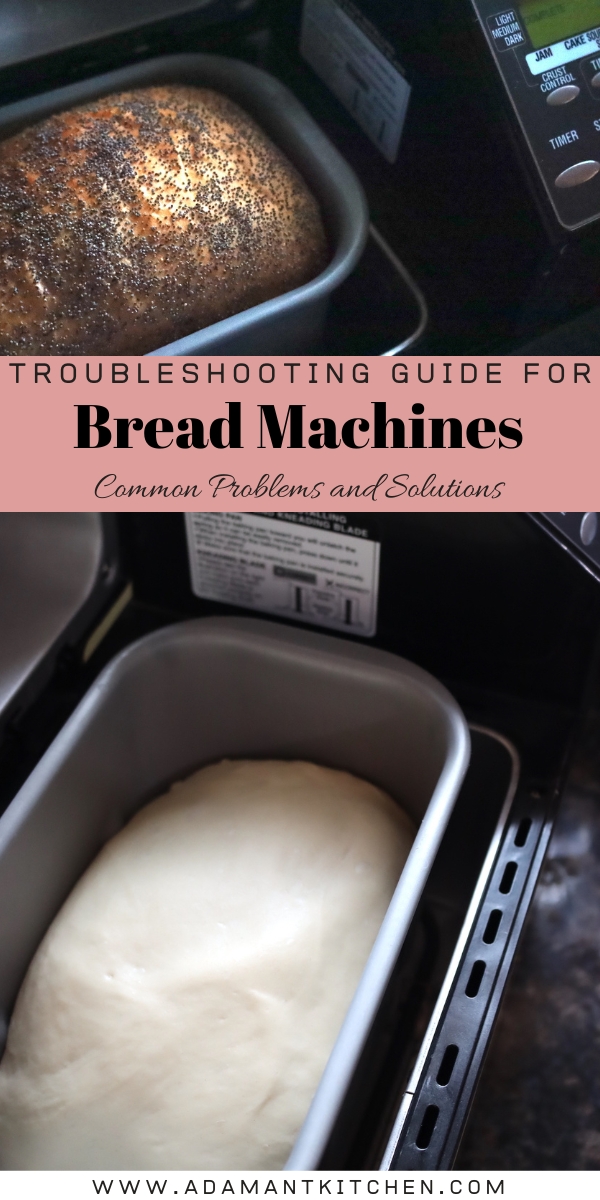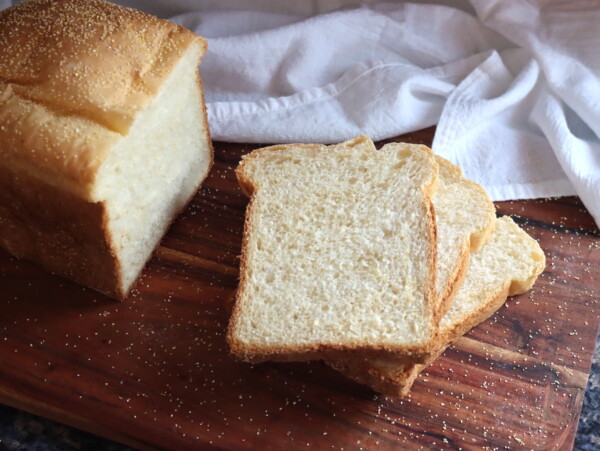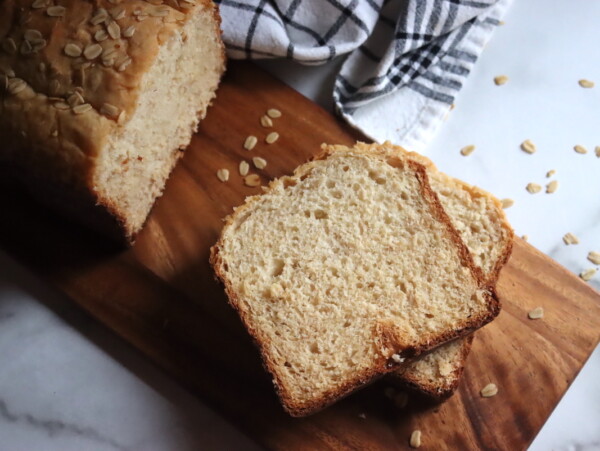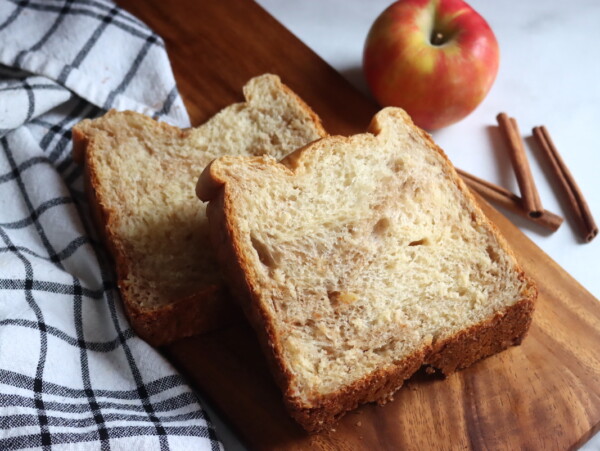This post may contain affiliate links. Please see our disclosure policy.
Bread machine problems can be frustrating, but there’s often a simple solution to get it right. If your loaf is collapsing, too dense, or underbaked, there may be a simple way to troubleshoot the issue and get it right every time.
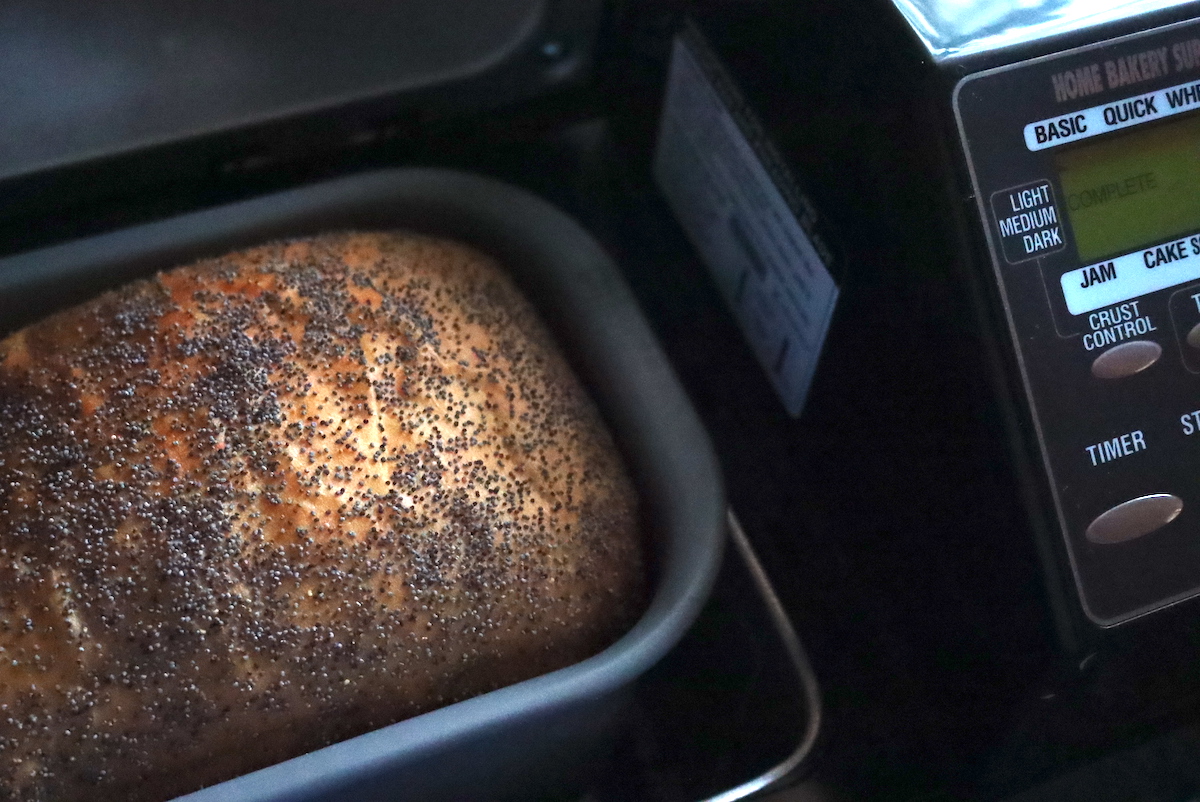
Bread machines are a convenient way to make bread at home, and they’re perfect for beginners…but that doesn’t mean they make flawless bread every time.
Bread machines aren’t perfect, and neither are people. Incorrect measurements, yeast issues, or machine malfunctions can sometimes cause problems that can leave you scratching your head (and maybe even tossing a failed loaf).
Whether you’re dealing with a loaf that won’t rise or a crust that’s too dark, this troubleshooting guide will help you to both find your problem and learn how to fix it.
Common Bread Machine Issues
Before I go through each of the most common issues you may face with your bread machine, these general tips apply to many of the issues listed below:
- Yeast Issues: Ensure your yeast is fresh. If you’re using expired yeast, it may not activate properly, leading to poor rise or texture. If you’re using a timer, be sure the yeast isn’t exposed to moisture before the machine starts. You can prevent this by placing dry ingredients around the yeast in the pan.
- Dough Consistency: During the kneading phase, check the consistency of the dough. It should form a soft, slightly tacky ball. If it’s too dry, add water 1 tablespoon at a time; if it’s too wet, add flour a little at a time.
- Reduced Salt: I know it may seem like salt is just there for flavor, but it actually regulates the activity of the yeast and helps set the structure of the loaf. If you want a reduced sodium bread, be sure to use a reduced sodium recipe rather than just omitting the salt.
- Weather Conditions: Warm, humid weather can affect your bread machine’s performance. If you live in a warm or tropical climate, try using cooler liquids, bake during the evening, or use the rapid cycle to reduce the risk of over-proofing.
- High Altitude: If you live at a high altitude, make sure to follow the appropriate adjustments for baking at altitude. This often includes reducing the yeast and liquid slightly and adjusting the baking time.
Now, I’ll go through the most common bread machine problems, one by one.
Top Inflated, Mushroom-like Shape
When the top of a loaf rises too much, it can create a mushroom-like shape, causing the dough to spill out of the pan or stick to the top of the bread machine. This can lead to a mess in your machine and potentially burnt dough.
Even if it doesn’t spill over, you may end up with an awkward, misshapen loaf that’s difficult to slice or store.
- Too Much Yeast: Excess yeast causes the bread to rise too quickly, leading to over-expansion. Reduce the yeast by ¼ to ½ teaspoon.
- Too Much Sugar: Extra sugar feeds the yeast too rapidly, encouraging it to rise too fast. Reduce sugar by 1 teaspoon.
- Too Much Flour: Too much flour makes the dough stiffer, leading to excessive gluten development and an over-inflated loaf. Reduce flour by 1-2 tablespoons. If the recipe seems too large for your machine, try halving it (e.g., use a 1 ½ lb recipe instead of a 2 lb one).
- Using the Wrong Yeast: Fast-rise or bread machine yeast is meant to rise quickly, and using it in a recipe that calls for regular instant yeast can cause the loaf to over-rise. Ensure you’re using the correct type of yeast for your recipe. If the recipe doesn’t specify, use regular instant yeast.
- Not Enough Salt: Salt helps slow down yeast activity and prevents over-expansion. Use the correct amount of salt in your recipe. You can usually reduce the salt slightly, but if you do, make sure you also reduce the yeast amount slightly.
- Warm, Humid Weather: Warm and humid conditions can cause yeast to overwork, leading to excessive rising. Reduce liquid by 1 tablespoon and yeast by ¼ to ½ teaspoon when baking in hot or humid conditions.
- High Altitude: At higher altitudes, the atmospheric pressure is lower, and dough rises faster. At altitudes above 3,000 feet, reduce liquid by 1 tablespoon and yeast by ¼ to ½ teaspoon.
Collapsed Loaf
A collapsed or sunken loaf can be incredibly frustrating. The loaf may fall inward or flatten after baking, leaving you with an unattractive and uneven result. Several factors can cause this, but with the right adjustments, you can avoid it next time.
- Too Much Dough for Pan: If you’ve overfilled the bread pan, there may not be enough room for the bread to rise properly without collapsing. Don’t exceed the pan’s recommended dough capacity.
- Incorrect Dough Consistency: If the dough is too wet or too dry, it may not have the structure it needs to rise properly and will collapse. Check the dough during the kneading cycle and adjust by adding flour or liquid as needed.
- Excess Yeast: Using too much yeast can cause the dough to rise too quickly, and then collapse once the machine stops baking. Measure yeast carefully and avoid exceeding the recommended amount.
- Wrong Type of Yeast: Too much yeast or fast-acting yeast can cause excessive rise and collapse. Use the correct amount of yeast and ensure it’s the right type.
- Too Much Sugar: Extra sugar can cause the yeast to rise too quickly, resulting in a collapsed loaf as the yeast exhaust themselves before the bread is set in baking. In savory breads, try using 1 tsp less sugar. In sweet breads, reduce the yeast amount by ¼ to ½ tsp.
- Not Enough Salt: Salt is not just for flavor, it’s acutally essential for controlling the yeast’s activity and ensuring the bread maintains its structure. If you forget to add salt, or don’t add enough, the dough can rise too quickly and collapse during baking.
- Warm, Humid Weather: Warm and humid weather can cause yeast to work too quickly, leading to rapid rising followed by a collapse before baking even begins. If you’re baking in hot or humid conditions, try baking during the coolest part of the day, use refrigerated liquids. You can also reduce liquid by 1 tablespoon and yeast by ¼ to ½ teaspoon which will help adjust for warm weather.
- High Altitude: At high altitudes, bread dough rises faster, which can cause it to collapse. Follow high-altitude baking instructions and reduce liquid and yeast slightly.
Center of Loaf Raw, Not Baked
A raw center can result from a number of issues, such as too much liquid or interruptions in the baking process.
- Too Much Liquid: Excess liquid can prevent the bread from cooking evenly, leaving the center raw. Reduce liquid by 1 tablespoon.
- Power Outage During Operation: If the power goes out mid-cycle, the loaf may not have baked long enough. If a power outage occurs, unfortunately, you’ll need to start the process over with fresh ingredients.
- Knead Bar Not Inserted Correctly: If the knead bar isn’t properly placed, it can cause uneven mixing and baking. Check that the knead bar is installed correctly before starting the process.
Gummy Texture
A gummy texture is often a sign that the bread has not baked thoroughly or that the dough’s consistency is off. This can result in a dense, moist interior that feels undercooked or sticky, even if it is technically fully cooked and has baked long enough.
- Too Much Liquid: If the dough has too much liquid, it may not bake evenly, leaving the center undercooked and gummy. Reduce the liquid by 1 tablespoon and check the dough’s consistency during the kneading cycle. The dough should be soft but not overly sticky.
- Incorrect Setting on the Bread Machine: Some bread machines have different settings for different types of bread (e.g., light or dark crust). If you’re using a setting that’s too short for a rich or dense dough, it may not bake all the way through. Try using a longer baking cycle, or adjust the crust setting for a darker option, which bakes the bread for a longer time.
- Not Enough Baking Time: In some cases, if you’re baking a larger or more complex recipe, the machine may not provide enough time to fully bake the loaf, leaving the center undercooked. Make sure your machine is set to the appropriate cycle for the bread you’re making, and be mindful of the total bake time.
- Too Much Yeast: Excessive yeast causes the bread to rise too quickly, potentially resulting in a loaf that doesn’t bake properly and retains a gummy interior. Reduce the yeast by ¼ to ½ teaspoon.
- Too Little Yeast: If the yeast is expired or there isn’t enough, the dough may not rise adequately, leading to a dense and gummy texture. Check the expiration date of your yeast and measure carefully to ensure you’re using the right amount.
Flat Loaf, No Rising
If your loaf doesn’t rise and ends up flat, it’s likely that there’s an issue with the yeast, liquids, or other key ingredients.
- Yeast Left Out: Missing yeast will result in no rise. Always double-check that the yeast is included in the recipe.
- Expired Yeast: Old or expired yeast won’t activate and lead to a flat loaf. Check the expiration date on your yeast before use.
- Liquid Too Warm: Yeast needs warm (but not hot) liquid to activate properly. Use lukewarm water (90-100°F) for activating yeast.
- Too Much Salt: Salt can kill the yeast if you use too much. Measure salt carefully according to the recipe.
- Forgot to Add Sweetener: Some recipes require sugar or honey to activate yeast. Double-check that any required sweeteners are included.
- Yeast Got Wet Before Process Started: If using a delayed start timer, moisture could have made contact with the yeast. Ensure the dry ingredients are pushed to the sides of the pan, with yeast in the center, especially if using a timer. Yeast that activates too early in delayed baking will exhaust itself before the process starts.
Short Loaf Volume
If your loaf appears smaller than expected, it may not have the right balance of ingredients or yeast.
- Typical for 1 lb. or Whole Wheat Loaf: Some recipes, especially whole wheat, naturally produce smaller loaves. Understand that some recipes may result in smaller loaves. If you’re making a 1 lb. or whole wheat recipe, this is normal.
- Not Enough Liquid: If the dough doesn’t have enough moisture, it will not rise as much. Increase liquid by 1 tablespoon.
- Sugar Left Out or Not Enough: Sugar helps with yeast activation and loaf volume. Ensure you’ve included the correct amount of sugar.
- Wrong Type of Flour: All-purpose flour isn’t ideal for bread making. Bread flour is best. Use bread flour, not all-purpose flour, for better structure.
- Too Little or Expired Yeast: Using too little yeast or expired yeast will result in under-risen dough. Use the correct amount of fresh yeast.
- Wrong Type of Yeast: Make sure you’re using the right type of yeast for your recipe. If your recipe calls for active dry yeast, don’t substitute with bread machine or instant yeast unless directed.
Bread Doesn’t Slice Well, Sticky
If the bread is too sticky or difficult to slice, it’s usually a result of the bread being too warm or the wrong slicing tools being used.
- Slicing While Too Warm: Slicing bread when it’s too hot will cause it to squish and stick together. Allow the bread to cool for 15-30 minutes before slicing.
- Not Using the Proper Knife: Using a dull or inappropriate knife can make slicing difficult and messy. Use a serrated bread knife for clean, even slices.
Open, Coarse, Holey Texture
This issue is often caused by incorrect ingredient measurements or yeast activity.
- Salt Left Out: Salt helps regulate yeast and improves dough structure. Always add the proper amount of salt as directed in the recipe.
- Too Much Yeast: Excess yeast can create air pockets and holes. Measure yeast carefully and avoid adding too much.
- Too Much Liquid: Too much liquid can cause holes and an uneven texture. Reduce liquid by 1 tablespoon.
Heavy, Dense Texture
If your bread comes out dense and heavy, it’s likely due to incorrect ingredient measurements or mixing issues.
- Too Much Flour: Adding too much flour makes the dough too stiff, leading to a heavy texture. Measure flour carefully and check consistency during kneading.
- Not Enough Liquid: If the dough lacks moisture, it can result in a dense loaf. Increase liquid slightly and monitor dough consistency during the kneading process.
- Yeast Issues: Using too little yeast or old yeast can result in a dense loaf. Use the correct amount of fresh yeast and make sure it’s active.
- Under-Kneading: Insufficient kneading can result in dense, heavy bread. Ensure the dough is kneaded thoroughly, allowing the gluten to develop fully.
Burned Loaf, Thick Crust, or Dark Crust Color
If your bread has a burnt exterior, an overly thick crust, or a very dark color, it can be a sign that the baking cycle or settings need some adjustment. These issues are often related to overbaking, incorrect settings, or ingredient imbalances.
- Too Long a Baking Cycle: If your bread bakes for too long, it can result in a burned loaf and overly dark or thick crust. Check your bread machine settings and make sure you’re using the correct cycle for the type of bread you’re baking (e.g., a lighter or medium crust setting). Use the light crust setting if your machine has one to help prevent overbaking.
- Dark Crust Setting: Using the “dark crust” setting can sometimes result in a crust that is too thick or too dark, especially if you’re baking a recipe that doesn’t need as much time. Try using the “light” or “medium” crust setting to ensure a more balanced result.
- Too Much Sugar: Sugar promotes browning and can cause the crust to become overly dark or even burn. If your recipe has a high sugar content, try reducing the sugar by 1 teaspoon to avoid excessive browning, or choose the “light” crust setting for sweet breads.
- Too Much Yeast: Excess yeast can cause the bread to rise too quickly, which may lead to overbaking in the machine’s heating cycle, resulting in a burned loaf or too thick of a crust. Use the correct amount of yeast and make sure you’re following the recipe’s recommendations.
- Wrong Type of Flour: Certain flours, such as bread flour, have more gluten and may create a denser loaf, leading to a thicker, chewier crust. If you find the crust is too thick or chewy for your tastes, try using all purpose flour instead.
- Power Surges or Machine Malfunction: If your machine malfunctions or experiences a power surge during baking, it could cause the bread to bake at an excessively high temperature, resulting in a burned loaf. If you suspect a malfunction, check your machine for any issues and consider calling for service.
Bread Sticks to Pan
Bread machine pans are supposed to be non-stick, but that doesn’t mean it’ll always work out that way in the real world. Sometimes, the problem is with the recipe, and other times, it’s the pan itself.
In general, you can help with this issue by lightly greasing the pan before you begin. Be sure to use butter or a neutral oil rather than cooking spray.
- Old Bread Pan: Over time, the non-stick coating inside the bread pan can wear down, causing the bread to stick. If this happens, you may need to replace the pan. Avoid using metal tools in nonstick pans, as they can scratch the coating. If your pan is relatively new and it’s happening for the first time with this recipe and other recipes bake fine, then your pan is likely not the problem.
- Incorrect Amount of Fat in the Recipe: Some bread recipes, especially those for soft or sweet breads, require added fat to help prevent sticking. If you’re not using the proper amount of butter, oil, or another fat, the bread may stick to the pan. If you’re making a low-fat recipe, you might want to consider adding a teaspoon of vegetable oil to the liquid ingredients to help with release.
- Don’t Use Cooking Spray: While it might seem like an easy solution, avoid using cooking sprays (like aerosol sprays) on your bread machine pan. These can leave a sticky residue that actually makes the bread stick more. Stick to using oil, shortening, or butter instead
- Not Allowing the Bread to Cool: If you try to remove the bread immediately after baking, it may stick because it hasn’t had time to set. Allow the bread to cool for about 10-15 minutes in the pan before trying to shake it out. This will help the loaf firm up and reduce the likelihood of sticking.
Tested Bread Machine Recipes
Sometimes, the issue is user error or machine error, but other times, it’s just a bad recipe. These are my favorite, time-tested bread machine recipes:
- Bread Machine Honey White Bread
- Bread Machine Whole Wheat Bread
- Bread Machine Brioche Bread
- Bread Machine Honey Oat Bread
